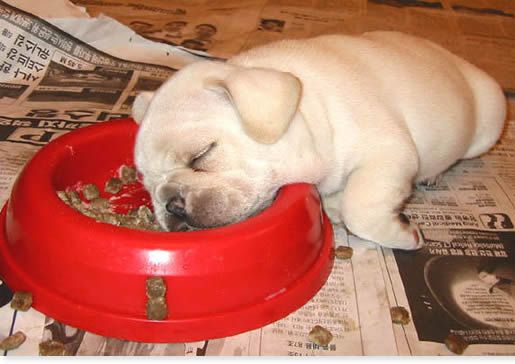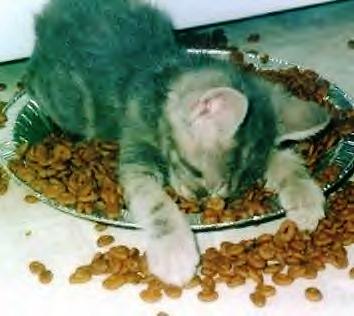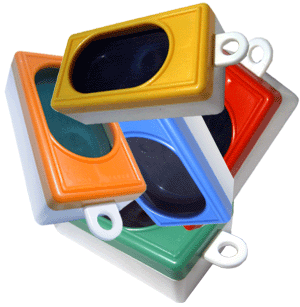Basic Feeding Guide
There are several important things to remember when feeding your dog or cat.
1. Pick a good quality food and stay with the same brand and flavor. DO NOT SWITCH EVERY TIME YOU BUY NEW FOOD.
Dogs and cats do not need variety and they do not need to be "tempted" into eating. If they don't eat what you put down it is for one of only TWO reasons. They are not hungry or they are sick. Changing foods all the time may cause upset stomachs or even food allergies.
2. Feed the pet twice daily (puppies and kittens may require more).
You should give your dog access to its food for 5 to 10 minutes, then pick up whatever he did not eat. If the dog does not eat anything, that's okay. Offer the evening meal the same way. Healthy dogs can go for days without eating with no ill effects, whereas cats need to eat on a regular basis.
Cats like to browse, so you may find they don't finish the entire meal at one sitting. That's okay. If they still have food left by the evening meal, you may be feeding too much.
If your pet is vomiting or has diarrhea and is not eating, see your vet immediately. If your cat goes 48 hours without eating, see your vet immediately.
Once the pet knows that they will only have a short access to the food, they will eat when you feed them. A healthy dog should eat the food offered within the 5 to 10 minute time period.
If food is left in the bowl, you are feeding too much.
3. You control the food.
If your pet is eating the proper amount, it should not be overweight and should not be leaving food in its bowl.
A good rule of thumb to follow:
Most ADULT dogs should eat about a 1/2 cup of dry dog food per 10 pounds of body weight. That means where their weight should be, if they are overweight, use the dogs optimal body weight. That being said, with large breed dogs, please monitor their weight carefully. This rule does not always apply, many 60 - 80 pound dogs eat much less than 3-4 cups a day.
So a 10 lb dog should get about 1/2 cup of dry food TOTAL daily. A 25 lb dog would get somewhere between 1 and 1.5 cups of dry food.
Most ADULT cats will eat about 1/2 a cup of dry food each day. Make sure that if you are also using canned food that you decrease the amount of dry to accomodate the additional calories.
You must remember that each pet will be different depending on their activity level, age and metabolism. Puppies and kittens will eat twice as much as their adult counterparts. Senior pets may eat less, or more.
4. Puppies and kittens grow up and need LESS food.
Puppies and kittens need more food to grow. At between 9 months and a year of age, most dogs and cats are almost full grown. Larger breed dogs will still be growing, but not as much.
IT IS EXTREMELY IMPORTANT to watch your pet's weight and not overfeed them as they reach adulthood. Also remember to change to an adult food when your pet is about 1 year old (again, large and giant breed dogs may stay on puppy food for another 6 months or so).
5. If you do need to change pet foods, do it slowly!
Even when you switch from puppy/kitten food to adult pet food, make sure you have enough puppy/kitten food left to mix with the adult food and gradually introduce the new food. Quick changes of diet can cause upset stomachs and even lead to food allergies. Try to stick to the same brand and flavor when you switch to the adult food.
6. Treats
Remember, treats are a part of your pet's diet as well. They need to figure in to his total daily calories. Most pets would much rather have 10 small 'pea-sized' treats than one large treat. And they eat them all just as fast!















